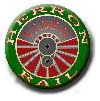
Herron Rail Video
About Herron Rail Video
 Operated by Jim Herron, an avid railroad enthusiast himself, HRV was launched in 1984 when Herron and
partner Charles A. Hegyes first got together to consider bringing out a spectacular collection of 1940's railroading
on video. Charlie Hegyes, a veteran industrial film producer, provided the technical knowledge to produce that
first film, THE GLORY MACHINES. For two years, GM was the only production we had. Then, in 1986, Volume 2
was produced from film acquired by Herron from C. H. Snyder, another Florida railfan. Charlie Hegyes passed away in 1986 and Herron continued the operation. Narrator Ralph E. Morse, a veteran of CBS radio and TV,
had narrated most of Hegye's industrial films and signed on to also narrate the railroad pictures. He continues
to narrate most of the programs today.
Operated by Jim Herron, an avid railroad enthusiast himself, HRV was launched in 1984 when Herron and
partner Charles A. Hegyes first got together to consider bringing out a spectacular collection of 1940's railroading
on video. Charlie Hegyes, a veteran industrial film producer, provided the technical knowledge to produce that
first film, THE GLORY MACHINES. For two years, GM was the only production we had. Then, in 1986, Volume 2
was produced from film acquired by Herron from C. H. Snyder, another Florida railfan. Charlie Hegyes passed away in 1986 and Herron continued the operation. Narrator Ralph E. Morse, a veteran of CBS radio and TV,
had narrated most of Hegye's industrial films and signed on to also narrate the railroad pictures. He continues
to narrate most of the programs today.
 Herron and Hegyes insisted that they would produce programs for railfans with the highest possible quality,
right from the beginning. Video transfers from 16mm original film have always been done by the best
facilities such as Disney/MGM studios in Florida or equally professional studios by computerized equipment
built by Rank Cintel, an English company. The typical Rank installation costs over $ 1 Million and most
broadcast TV programs that come from film also use this technology. The Rank allows the operator to
improve each scene's color and contrast settings. The film is run scene by scene, analyzed, and programmed
before being re-run for the transfer. A typical 1 hour film can take as much as 12-15 hours of time on the
Rank. Transfers are put on either 1 inch video tape, BetacamSP tape or D2 digital tape. The cost of such
transfers runs around $ 250 - $ 350 per hour, depending on conditions and the facility used. The results
are worth the cost when the final product is watched on television.
Herron and Hegyes insisted that they would produce programs for railfans with the highest possible quality,
right from the beginning. Video transfers from 16mm original film have always been done by the best
facilities such as Disney/MGM studios in Florida or equally professional studios by computerized equipment
built by Rank Cintel, an English company. The typical Rank installation costs over $ 1 Million and most
broadcast TV programs that come from film also use this technology. The Rank allows the operator to
improve each scene's color and contrast settings. The film is run scene by scene, analyzed, and programmed
before being re-run for the transfer. A typical 1 hour film can take as much as 12-15 hours of time on the
Rank. Transfers are put on either 1 inch video tape, BetacamSP tape or D2 digital tape. The cost of such
transfers runs around $ 250 - $ 350 per hour, depending on conditions and the facility used. The results
are worth the cost when the final product is watched on television.
Because almost all amateur film is silent, it is necessary to build sound effects tracks from scratch in order to produce a "believable" video program. Herron does this himself, watching each scene and matching audio effects from his extensive collection of railroad sounds. Occasionally, original sound is found on old tape recordings that matches the picture and was recorded on the scene when the film was shot but this is rare. Don Krofta's film has many original sounds because we have used recordings made at the time by his friend, Jim Hawk. Most of the time, sounds must be pulled from the audio vault and matched to the picture. This is a time consuming process and takes as much as a two weeks on a typical production. Again, Herron feels the results are worth it to the customer because the scenes come alive with proper sound effects. The audio is built scene by scene on an 8 track recorder. Also, Herron is continually found in the field recording new sound effects to use in productions. All recording is now done on Digital Audio Tape (DAT).
All video editing is done by professional outside studios under the direction of Herron. Also, the narration is recorded by outside studios and the final audio mix is laid to the original master tape by an outside studio. Currently, we record narration via fibre optics link from Boston to Tampa since our narrator lives in Boston.
While all of this is going on, Herron also designs and produces all ad layouts and video box designs in the Herron studio via a MacIntosh computer. Photos are scanned, layouts created, and sent to printers or magazines for placement. The printer ships the completed boxes to a company in Pittsburgh where all HRV videos are stocked and shipped.
So you see, the production of Herron Rail Videos is a long and expensive process. But we all feel the extra expense is necessary to bring you, our customer, videos of the highest possible quality. This is why our slogan is Quality. the difference is on the screen.
Return to Herron Home Page